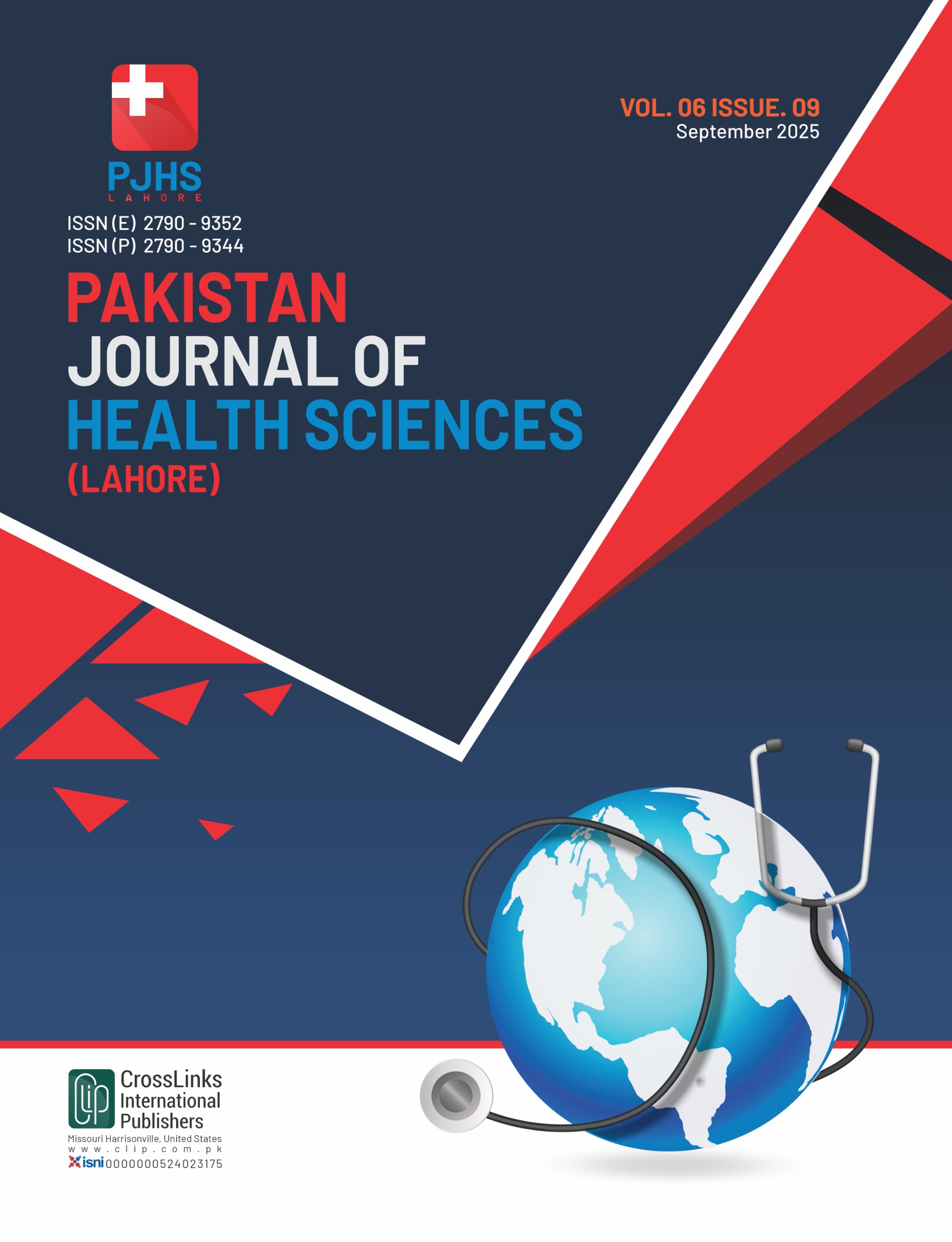Assessment of Maxillary Premolar Root Position Within the Alveolar Bone Using Cone Beam Computed Tomography
Cone Beam Computed Tomography Assessment of Maxillary Premolar Roots
DOI:
https://doi.org/10.54393/pjhs.v6i9.3127Keywords:
Maxilla, Premolars, Maxillary sinus, Alveolar bone lossAbstract
The location of maxillary premolars with respect to the alveolar bone and maxillary sinus is critical for treatments like extractions and implantation. CBCT imaging provides extensive information on root placement, sinus proximity, and buccal bone dimensions, enabling proper diagnosis and treatment planning. Objectives: To assess the position of the maxillary premolars’ roots within the alveolar apparatus and their relationship to the maxillary sinus using cone-beam computed tomography. Methods: This is a cross-sectional descriptive study that included CBCT images of 105 patients with 411 maxillary premolars were viewed retrospectively over a period of six months. After obtaining permission from the institutional ethical review committee, each pair of premolars was observed on either side of the mouth. Each exhibited a distinct association between its root tip and the sinus floor, categorized into four different types. The roots were also variable in the alveolar housing and were either buccal, middle, or palatally placed. Results: In our study, the majority of maxillary first premolars had roots positioned away from the sinus floor, with root angulation predominantly directed toward the buccal side. In contrast, most second premolars exhibited roots located close to or extending into the sinus floor, with their roots generally positioned centrally within the alveolar bone. Conclusions: Maxillary first premolars have weaker buccal bone, whereas second premolars are more affected by sinus proximity during implant insertion operations. Given these specific anatomical obstacles, CBCT imaging is recommended for accurate diagnosis and effective implant design.
References
Jung YH, Cho BH, Hwang JJ. Analysis of the Root Position and Angulation of Maxillary Premolars in Alveolar Bone Using Cone-Beam Computed Tomography. Imaging Science in Dentistry. 2022 Sep; 52(4): 365. doi: 10.5624/isd.20220710. DOI: https://doi.org/10.5624/isd.20220710
Zhan Y, Wang M, Cheng X, Liu F. Classification of Premolars Sagittal Root Position and Angulation for Immediate Implant Placement: A Cone Beam Computed Tomography Study. Oral Surgery, Oral Medicine, Oral Pathology, and Oral Radiology. 2023 Feb; 135(2): 175-84. doi: 10.1016/j.oooo.2022.05.013. DOI: https://doi.org/10.1016/j.oooo.2022.05.013
Liao WC, Chang SH, Chang HH, Chen CH, Pan YH, Yeh PC, et al. An Analysis of the Relevance and Proximity Between Maxillary Posterior Root Apices to the Maxillary Sinus and the Buccal Cortical Bone Plate. Journal of Dental Sciences. 2024 Oct; 19(4): 1972-82. doi: 10.1016/j.jds.2024.07.019. DOI: https://doi.org/10.1016/j.jds.2024.07.019
Shaul Hameed K, Abd Elaleem E, Alasmari D. Radiographic Evaluation of the Anatomical Relationship of Maxillary Sinus Floor with Maxillary Posterior Teeth Apices in the Population of Al-Qassim, Saudi Arabia, Using Cone Beam Computed Tomography. Saudi Dental Journal. 2020; 33: 769-74. doi: 10.1016/j.sdentj.2020.03.008. DOI: https://doi.org/10.1016/j.sdentj.2020.03.008
Makris LM, Devito KL, D'Addazio PS, Lima CO, Campos CN. Relationship of Maxillary Posterior Roots to the Maxillary Sinus and Cortical Bone: A Cone Beam Computed Tomographic Study. General Dentistry. 2020 Mar; 68(2): e1-4.
Kong ZL, Tu YY, Xu DQ, Ding X. Estimating the Occurrence of Labial Bone Perforation and Implantation into the Maxillary Sinus Maxillary Premolars Based on the Morphology of Maxillary Premolars: A Clinical Study. Journal of Prosthetic Dentistry. 2023 Jun; 129(6): 887-e1. doi: 10.1016/j.prosdent.2023.04.001. DOI: https://doi.org/10.1016/j.prosdent.2023.04.001
Nalbantoğlu AM, Yanık D. Evaluation of Facial Alveolar Bone Thickness and Fenestration of the Maxillary Premolars. Archives of Oral Biology. 2022 Oct; 142: 105522. doi: 10.1016/j.archoralbio.2022.105522. DOI: https://doi.org/10.1016/j.archoralbio.2022.105522
Kheur M, Kalsekar S, Kheur S, Jung RE, Lakha T. Feasibility of Immediate Implant Placement in Maxillary First Premolars: Prediction of Implant Locations Using Restorations - A Radiographic Study. International Journal of Prosthodontics. 2024 Mar; Epub ahead. doi: 10.11607/ijp.8757. DOI: https://doi.org/10.11607/ijp.8757
Alqutaibi AY, Aloufi AM, Hamadallah HH, Khaleefah FA, Tarawah RA, Almuzaini AS, et al. Multifactorial Analysis of the Maxillary Premolar Area for Immediate Implant Placement Using Cone Beam Computed Tomography: A Study of 333 Maxillary Images. Journal of Prosthetic Dentistry. 2024 Aug. doi: 10.1016/j.prosdent.2024.07.010. DOI: https://doi.org/10.1016/j.prosdent.2024.07.010
Akotiya BR, Surana A, Chauhan P, Saha SG, Agarwal RS, Vashisht A. Morphometric Analysis of the Relationship Between Maxillary Posterior Teeth and Maxillary Sinus Floor in Central Indian Population: A Cone-Beam Computed Tomography Study. Journal of Conservative Dentistry and Endodontics. 2024 Apr; 27(4): 373-7. doi: 10.4103/JCDE.JCDE_353_23. DOI: https://doi.org/10.4103/JCDE.JCDE_353_23
Razumova S, Brago A, Howijieh A, Manvelyan A, Barakat H, Baykulova M. Evaluation of the Relationship Between the Maxillary Sinus Floor and the Root Apices of the Maxillary Posterior Teeth Using Cone-Beam Computed Tomographic Scanning. Journal of Conservative Dentistry and Endodontics. 2019 Mar; 22(2): 139-43. doi: 10.4103/JCD.JCD_530_18. DOI: https://doi.org/10.4103/JCD.JCD_530_18
Yoshimine SI, Nishihara K, Nozoe E, Yoshimine M, Nakamura N. Topographic Analysis of Maxillary Premolars and Molars and Maxillary Sinus Using Cone Beam Computed Tomography. Implant Dentistry. 2012 Dec; 21(6): 528-35. doi: 10.1097/ID.0b013e31827464fc. DOI: https://doi.org/10.1097/ID.0b013e31827464fc
Morsy EK, El Dessouky SH, Ghafar EA. Assessment of Proximity of the Maxillary Premolars Roots to the Maxillary Sinus Floor in a Sample of Egyptian Population Using CBCT: An Observational Cross-Sectional Study. Journal of International Oral Health. 2022 May; 14(3): 306-15. doi: 10.4103/jioh.jioh_355_21. DOI: https://doi.org/10.4103/jioh.jioh_355_21
Yan Y, Li J, Zhu H, Liu J, Ren J, Zou L. CBCT Evaluation of Root Canal Morphology and Anatomical Relationship of Root of Maxillary Second Premolar to Maxillary Sinus in a Western Chinese Population. BMC Oral Health. 2021 Jul; 21(1): 358. doi: 10.1186/s12903-021-01714-w. DOI: https://doi.org/10.1186/s12903-021-01714-w
Petaibunlue S, Serichetaphongse P, Pimkhaokham A. Influence of the Anterior Arch Shape and Root Position on Root Angulation in the Maxillary Esthetic Area. Imaging Science in Dentistry. 2019 Jun; 49(2): 123-30. doi: 10.5624/isd.2019.49.2.123. DOI: https://doi.org/10.5624/isd.2019.49.2.123
Shafizadeh M, Tehranchi A, Shirvani A, Motamedian SR. Alveolar Bone Thickness Overlying Healthy Maxillary and Mandibular Teeth: A Systematic Review and Meta-Analysis. International Orthodontics. 2021 Sep; 19(3): 389-405. doi: 10.1016/j.ortho.2021.07.002. DOI: https://doi.org/10.1016/j.ortho.2021.07.002
Khoury J, Ghosn N, Mokbel N, Naaman N. Buccal Bone Thickness Overlying Maxillary Anterior Teeth: A Clinical and Radiographic Prospective Human Study. Implant Dentistry. 2016 Aug; 25(4): 525-31. doi: 10.1097/ID.0000000000000427. DOI: https://doi.org/10.1097/ID.0000000000000427
Heimes D, Schiegnitz E, Kuchen R, Kämmerer PW, Al-Nawas B. Buccal Bone Thickness in Anterior and Posterior Teeth - A Systematic Review. Healthcare. 2021 Nov; 9(12): 1663. doi: 10.3390/healthcare9121663. DOI: https://doi.org/10.3390/healthcare9121663
Andre A, Ogle OE. Vertical and Horizontal Augmentation of Deficient Maxilla and Mandible for Implant Placement. Dental Clinics. 2021 Jan; 65(1): 103-23. doi: 10.1016/j.cden.2020.09.009. DOI: https://doi.org/10.1016/j.cden.2020.09.009
Vera C, De Kok IJ, Reinhold D, Limpiphipatanakorn P, Yap AK, Tyndall D, et al. Evaluation of Buccal Alveolar Bone Dimension of Maxillary Anterior and Premolar Teeth: A Cone Beam Computed Tomography Investigation. International Journal of Oral and Maxillofacial Implants. 2012 Dec; 27(6).
Cicciù M, Pratella U, Fiorillo L, Bernardello F, Perillo F, Rapani A, et al. Influence of Buccal and Palatal Bone Thickness on Post-Surgical Marginal Bone Changes Around Implants Placed in Posterior Maxilla: A Multi-Centre Prospective Study. BMC Oral Health. 2023 May; 23(1): 309. doi: 10.1186/s12903-023-02991-3. DOI: https://doi.org/10.1186/s12903-023-02991-3
Downloads
Published
How to Cite
Issue
Section
License
Copyright (c) 2025 Pakistan Journal of Health Sciences

This work is licensed under a Creative Commons Attribution 4.0 International License.
This is an open-access journal and all the published articles / items are distributed under the terms of the Creative Commons Attribution License, which permits unrestricted use, distribution, and reproduction in any medium, provided the original author and source are credited. For comments













